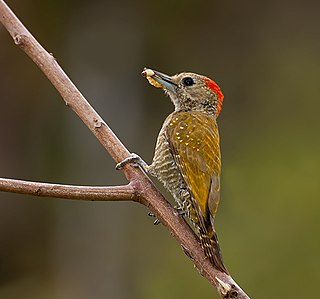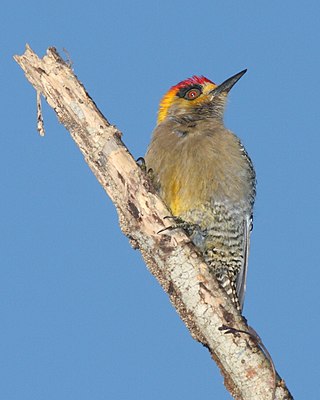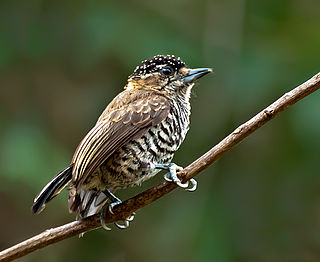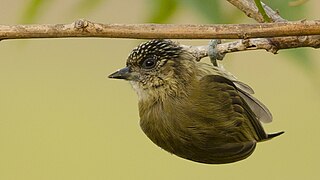
The piculets are a distinctive subfamily, Picumninae, of small woodpeckers which occur mainly in tropical South America, with just three Asian and one African species.

The golden-olive woodpecker is a species of bird in the subfamily Picinae of the woodpecker family Picidae. It is found from Mexico south and east through Panama, in every mainland South American country except Chile, Paraguay, and Uruguay, and Trinidad and Tobago.

The Hispaniolan woodpecker is a medium-sized woodpecker endemic to the Caribbean island of Hispaniola.

The little woodpecker is a species of bird in subfamily Picinae of the woodpecker family Picidae. It is found in every mainland South American country except Chile, Suriname, and Uruguay.

The spot-breasted woodpecker or spot-breasted flicker is a species of bird in subfamily Picinae of the woodpecker family Picidae. It is found in Panama and every mainland South American country except Argentina, Chile, Paraguay, and Uruguay.

The golden-cheeked woodpecker is a species of bird in subfamily Picinae of the woodpecker family Picidae. It is endemic to Mexico.

The golden-green woodpecker is a species of bird in subfamily Picinae of the woodpecker family Picidae. It is found in Panama and every mainland South American country except Chile and Uruguay.

The white-wedged piculet is a species of bird in subfamily Picumninae of the woodpecker family Picidae. It is found in Argentina, Bolivia, Brazil and Paraguay.

The bar-breasted piculet is a species of bird in subfamily Picumninae of the woodpecker family Picidae. It is found in Bolivia, Brazil, Colombia, and Peru.

The white-barred piculet is a species of bird in the woodpecker family Picidae. It is found in Argentina, Bolivia, Brazil, French Guiana, Guyana, Paraguay, and Uruguay.

The ocellated piculet is a species of bird in subfamily Picumninae of the woodpecker family Picidae. It is found in Bolivia and Peru and possibly Argentina.

The golden-spangled piculet is a species of bird in subfamily Picumninae of the woodpecker family Picidae. It is found in Brazil, Colombia, French Guiana, Guyana, Suriname, and Venezuela.

The greyish piculet is a species of bird in subfamily Picumninae of the woodpecker family Picidae. It is endemic to Colombia.

Lafresnaye's piculet is a species of bird in subfamily Picumninae of the woodpecker family Picidae. It is found in Brazil, Colombia, Ecuador, and Peru.

The arrowhead piculet or Guianan piculet is a species of bird in subfamily Picumninae of the woodpecker family Picidae. It is found in Suriname and possibly French Guiana and Guyana.

The olivaceous piculet is a species of bird in subfamily Picumninae of the woodpecker family Picidae. It is found from Guatemala south through Central America and western South America to Peru.

The rufous-breasted piculet is a species of bird in subfamily Picumninae of the woodpecker family Picidae. It is found in Bolivia, Brazil, Colombia, Ecuador, and Peru.

The scaled piculet is a species of bird in subfamily Picumninae of the woodpecker family Picidae. It is found in Colombia and Venezuela.

The fine-barred piculet is a species of bird in subfamily Picumninae of the woodpecker family Picidae. It is found in Brazil and Peru.

The yellow-vented woodpecker is a species of bird in subfamily Picinae of the woodpecker family Picidae. It is found in Colombia, Ecuador, Peru, and Venezuela.































